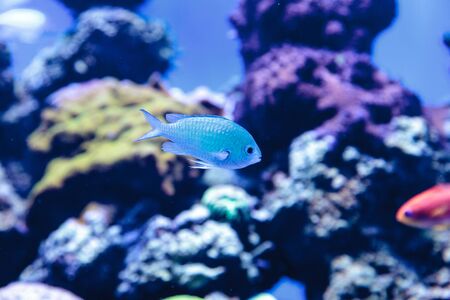1. Introduction to Coral Growth and Lighting
Lighting plays a crucial role in the health and growth of corals in reef aquariums. Corals have a unique symbiotic relationship with microscopic algae called zooxanthellae, which live within their tissues. These tiny algae perform photosynthesis, converting light into energy that helps corals thrive.
Why Lighting Matters for Corals
In the wild, corals receive natural sunlight, which provides the necessary spectrum and intensity for photosynthesis. In a reef aquarium, proper lighting must be carefully managed to mimic these natural conditions. Without adequate light, corals may lose their vibrant colors, experience stunted growth, or even die.
The Role of Photosynthesis
Zooxanthellae use light to produce oxygen and organic compounds that serve as food for the coral. In return, the coral provides protection and essential nutrients to the algae. This delicate balance is essential for coral survival and overall reef stability.
Key Factors of Aquarium Lighting
| Factor | Importance |
|---|---|
| Light Spectrum | Certain wavelengths (blue and UV) are essential for photosynthesis and coral coloration. |
| Light Intensity | Sufficient brightness ensures proper energy production but too much can cause bleaching. |
| Photoperiod | The duration of light exposure should mimic natural daylight cycles for optimal coral health. |
| Light Placement | The positioning of lights affects how evenly corals receive illumination. |
Mimicking Natural Sunlight in Aquariums
Aquarists often use specialized LED or T5 fluorescent lighting systems designed to replicate sunlight’s spectrum. Adjusting intensity and photoperiod helps maintain a stable environment where corals can flourish.
2. Types of Lighting Used in Reef Aquariums
Choosing the right lighting for a reef aquarium is crucial for coral health and growth. Different types of lighting provide varying levels of intensity, spectrum, and energy efficiency. Below, we discuss the three most common lighting options used in reef tanks: LED, T5 fluorescent, and metal halide.
LED Lighting
LED (Light Emitting Diode) lighting has become the most popular choice for reef aquariums due to its energy efficiency and customizable spectrum. Many modern LED fixtures allow users to adjust the intensity and color spectrum to match the specific needs of their corals.
Advantages of LED Lighting:
- Energy-efficient with lower electricity consumption
- Long lifespan (often 50,000+ hours)
- Customizable spectrum and intensity
- Produces less heat, reducing the need for additional cooling
Disadvantages of LED Lighting:
- Higher initial cost compared to other lighting options
- Some models may create uneven light distribution
- Requires proper setup to prevent coral light shock
T5 Fluorescent Lighting
T5 fluorescent lighting has been a reliable choice for reef tanks for many years. It provides even light distribution and works well for both soft and hard corals.
Advantages of T5 Fluorescent Lighting:
- Even light spread across the tank
- Easier to achieve optimal PAR levels for coral growth
- A more affordable option compared to LEDs
Disadvantages of T5 Fluorescent Lighting:
- Bulbs need regular replacement (typically every 9-12 months)
- Lacks spectrum customization compared to LEDs
- Generates more heat than LEDs, requiring cooling solutions
Metal Halide Lighting
Metal halide lights were once the gold standard for reef aquariums due to their ability to penetrate deep water and support high-light corals. However, they are less commonly used today due to advancements in LED technology.
Advantages of Metal Halide Lighting:
- Mimics natural sunlight, promoting strong coral growth
- Pentrates deep tanks effectively
- Tried-and-tested method for SPS corals
Disadvantages of Metal Halide Lighting:
- High energy consumption leads to increased electricity costs
- Bulbs generate significant heat, requiring additional cooling systems
- Lamps need periodic replacement, adding long-term costs
Comparison of Reef Aquarium Lighting Options
| Lighting Type | Main Advantages | Main Disadvantages |
|---|---|---|
| LED | – Energy-efficient – Long lifespan – Customizable spectrum – Low heat production |
– Higher initial cost – Can create uneven light distribution – Requires careful adjustment to avoid coral stress |
| T5 Fluorescent | – Even light spread – Affordable upfront cost – Good for various coral types |
– Bulbs need frequent replacement – Lacks customization – Generates moderate heat |
| Metal Halide | – Excellent penetration for deep tanks – Mimics natural sunlight – Great for high-light corals |
– High energy consumption – Significant heat output – Bulbs require regular replacement |
The choice between these lighting options depends on factors such as tank size, coral species, budget, and personal preference. Each type has its strengths and weaknesses, so selecting the best one requires balancing performance and cost.
![]()
3. Light Intensity and Spectrum Effects on Coral
Lighting plays a crucial role in the health and growth of corals in reef aquariums. The intensity and spectrum of light can significantly impact coral coloration, growth rates, and overall well-being. Understanding how different lighting conditions affect your corals can help you create an optimal environment for them to thrive.
How Light Intensity Affects Coral Growth
Light intensity is measured in PAR (Photosynthetically Active Radiation), which determines how much usable light energy is available for coral photosynthesis. Different coral species have varying light intensity needs:
| Coral Type | Recommended PAR Level | Effects of Too Much or Too Little Light |
|---|---|---|
| Soft Corals (e.g., Zoanthids, Mushrooms) | 50-150 PAR | Too much: Bleaching; Too little: Slow growth, dull colors |
| LPS Corals (e.g., Torch, Hammer, Frogspawn) | 100-200 PAR | Too much: Tissue damage; Too little: Poor expansion, slow growth |
| SPS Corals (e.g., Acropora, Montipora) | 200-400 PAR | Too much: Bleaching; Too little: Loss of vibrant colors, slow or no growth |
The Role of Light Spectrum in Coral Health
The color spectrum of light influences coral pigmentation and overall health. Corals contain symbiotic algae called zooxanthellae, which rely on specific wavelengths of light for photosynthesis. Here’s how different spectrums affect corals:
Red & Green Light
– Encourages algae growth, which can outcompete corals for nutrients.
– Minimal benefit for coral photosynthesis.
Blue & Violet Light (400-500nm)
– Essential for coral photosynthesis and pigmentation.
– Enhances fluorescent proteins in corals, making them appear more vibrant.
UV Light (380-400nm)
– Helps develop protective pigments in corals.
– Can enhance coloration but excessive UV exposure may cause stress.
Finding the Right Balance for Your Reef Tank
A combination of proper light intensity and spectrum is key to maintaining healthy and colorful corals. Many reef aquarium lights allow customization of these settings to mimic natural sunlight conditions. Monitoring coral response and adjusting lighting accordingly will ensure optimal growth and coloration.
4. Photoperiod and Coral Growth
Understanding Photoperiod
Photoperiod refers to the duration of light exposure in a reef aquarium. In natural coral reef environments, the amount of daylight varies slightly depending on geographic location and season. Mimicking these natural lighting cycles is essential for maintaining healthy coral growth.
Why Photoperiod Matters
The right photoperiod helps corals regulate their biological processes, including photosynthesis, feeding, and reproduction. Too much or too little light exposure can lead to stress, bleaching, or inhibited growth. By simulating a proper day-night cycle, aquarists can support coral health and promote optimal development.
Recommended Photoperiod for Reef Aquariums
A well-balanced lighting schedule should consist of different phases that mimic sunrise, midday, sunset, and nighttime conditions. Below is a general guideline for an ideal photoperiod:
| Lighting Phase | Duration | Description |
|---|---|---|
| Dawn (Ramp-Up) | 1-2 hours | Gradual increase in light intensity to simulate sunrise. |
| Full Daylight | 6-8 hours | Main photoperiod where corals receive strong illumination for photosynthesis. |
| Dusk (Ramp-Down) | 1-2 hours | Slow dimming of lights to replicate sunset conditions. |
| Nighttime | 8-12 hours | No direct lighting; moonlight or very low blue lighting can be used. |
Tuning Photoperiod for Different Coral Types
The ideal photoperiod may vary depending on the types of corals in your reef tank. For example:
- SPS Corals (Small Polyp Stony): Require longer periods of intense lighting, around 8 hours of full daylight.
- LPS Corals (Large Polyp Stony): Prefer moderate lighting with around 6-7 hours of full daylight.
- Soft Corals: Can thrive with shorter daylight periods and lower intensity lighting.
Avoiding Common Photoperiod Mistakes
Mistakes in photoperiod settings can negatively impact coral health. Here are some common issues and how to avoid them:
- Too Much Light: Overexposure can cause bleaching and stress. Ensure your full daylight period does not exceed recommended durations.
- Sudden Light Changes: Rapid changes in light intensity can shock corals. Use gradual transitions between phases.
- No Night Cycle: Corals need darkness to rest and recover. Avoid keeping lights on 24/7.
Tweaking Your Lighting Schedule Over Time
Certain factors such as coral acclimation, seasonal adjustments, and specific species requirements may require fine-tuning your photoperiod over time. Observing coral response and making gradual changes will help maintain a thriving reef aquarium.
5. Challenges and Best Practices for Aquarium Lighting
Maintaining the right lighting conditions in a reef aquarium can be challenging. Issues like excessive algae growth, coral bleaching, and inconsistent light distribution can impact coral health. In this section, well explore common lighting challenges and provide best practices to ensure an optimal environment for your reef tank.
Common Lighting Challenges
Algae Growth
One of the most common issues reef aquarists face is excessive algae growth. Too much light or prolonged exposure can encourage nuisance algae to thrive, outcompeting corals for nutrients.
Coral Bleaching
Improper lighting intensity or spectrum can cause coral bleaching, where corals expel their symbiotic zooxanthellae, leading to loss of color and weakened health.
Inconsistent Light Distribution
If light is not evenly distributed throughout the tank, some corals may receive too much or too little light, leading to uneven growth and stress.
Best Practices for Optimal Lighting
To maintain a healthy lighting environment, consider these strategies:
| Challenge | Solution |
|---|---|
| Excessive Algae Growth | Avoid overexposure by setting a proper photoperiod (8-10 hours per day). Use high-quality LED lights with adjustable intensity and spectrum. |
| Coral Bleaching | Gradually acclimate new corals to your lighting setup using a ramp-up period. Ensure the spectrum mimics natural sunlight with proper PAR levels. |
| Poor Light Distribution | Use multiple light sources or diffusers to ensure even coverage across the entire tank. Adjust placement based on coral needs. |
Selecting the Right Lighting Equipment
The choice of lighting equipment plays a crucial role in maintaining a balanced reef environment. LED lighting has become popular due to its energy efficiency and customizable spectrum. T5 fluorescent lights also remain a reliable option for even coverage.
Tuning Your Light Spectrum
A proper balance of blue and white light ensures optimal coral growth. Blue light supports photosynthesis in corals, while white light provides full-spectrum illumination. Many modern aquarium lights allow for custom tuning to match coral requirements.
The Importance of Regular Maintenance
Aquarium lighting should be monitored regularly to prevent issues from arising:
- Clean Light Fixtures: Dust and salt buildup can reduce light penetration. Wipe down fixtures weekly.
- Monitor Light Intensity: Use a PAR meter to check if your corals are receiving adequate light.
- Avoid Sudden Changes: Gradually adjust settings when changing bulbs or upgrading fixtures.
A well-maintained lighting system ensures that your corals receive the necessary energy for healthy growth while preventing common problems like algae overgrowth and bleaching. By following these best practices, you can create a thriving reef ecosystem in your aquarium.


